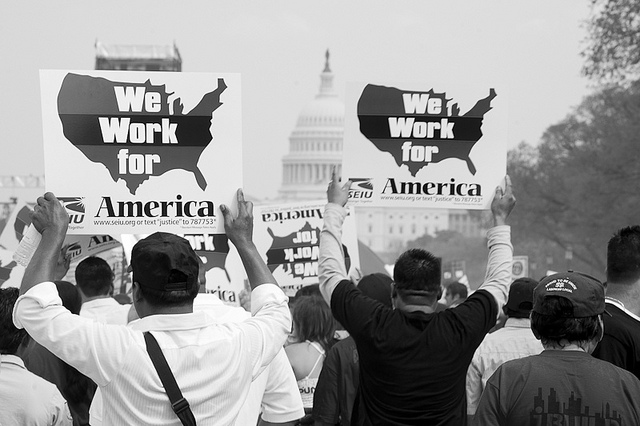
Exactly seven years ago, on May 1, 2006, millions of people in cities across America took to the streets to protest against harsh proposed changes in immigration policy. Today, a very different sort of legislation is on the table—an immigration reform bill that will change the legal status of millions of people already in the U.S. and possibly bring in many more millions of people from all economic strata, all over the world.
At a Zócalo/Azteca America Event presented in partnership with the California Community Foundation at the California Endowment, a panel of scholars asked what this legislation’s passage might mean for Los Angeles, California, and the nation.
“What happens when 11 million people move from this kind of outcast status to membership in our society?” asked Roberto Suro, director of the Tomás Rivera Policy Institute and the evening’s moderator. “What happens to them, what happens to their families, their schools, their jobs, their landlords, their communities—what happens to us?”
There are an estimated 11.2 million undocumented immigrants in the United States; 2.6 million of them live in California, noted USC sociologist Manuel Pastor. “This is going to be a very significant thing for California,” he said. And its effects will ripple far beyond those 2.6 million. Six percent of heads of households in California are undocumented; 70 percent of those families also have a citizen in the household. In Los Angeles County, half a million children have at least one undocumented parent—and over 80 percent of those children were born in the U.S. Legislation will change these children, these families, their schools, and their communities. “We all have a big stake in getting this right,” said Pastor.
Marcelo Suárez-Orozco, dean of the UCLA Graduate School of Education, said that the 5 million children of undocumented immigrants in the U.S. are affected in myriad ways by their parents’ status. By age 3, they begin to show cognitive delays. The challenge is going to be educating these children, giving them the skills they need to succeed, and preparing them to enter a globalized labor force—even as the state of California invests less and less in education.
Gilbert Ojeda, director of the UC Berkeley School of Public Health California Program on Access to Care, was more optimistic. He believes that the passage of legislation will empower both undocumented immigrants and those connected to them. The labor force will be able to organize, and people who for a decade haven’t been able to return home will go back and forth from Mexico to the U.S. And when it comes to healthcare, he said, undocumented immigrants who have become accustomed to subpar care are going to demand better.
Turning to Pastor, Suro asked whether Los Angeles and its community-based organizations have the capacity to both legalize and further integrate the 900,000 people whose status stands to change.
Pastor said that the country has never processed this volume of immigrants in a single year. In 2007, when it was announced that naturalization laws would change, there were 700,000 more applicants—and the nation ended up with a yearlong backlog. The bureaucratic and logistical challenge is significant.
In addition to concerns about strains on government and social services, there are also questions about what this influx of immigrants will mean for the labor force. The reform on the table will bring in university students as well as highly skilled, well-educated workers from other countries. Suro asked Suárez-Orozco if we’re setting ourselves up to have adult immigrants eventually competing with the children of immigrants for spots in California universities.
American universities need immigrants, said Suárez-Orozco. And the type of immigrants who are arriving in higher education cost the U.S. nothing. Added Pastor, there’s an army of nannies and gardeners and food service workers for every software engineer. In places like Silicon Valley, there’s a large undocumented population of unskilled service workers who are going to benefit from immigration reform alongside educated, highly skilled members of the labor force.
In the question-and-answer session, audience members asked the panelists to talk more about immigration reform and the American workforce.
We’re already struggling with unemployment in America, said one audience member. How will this flow of new immigrants affect that?
Pastor acknowledged that it’s surprising to see this type of reform coupled with a deep economic crisis. But he argued that evidence shows that immigrants are conducive to economic growth—they have high rates of labor force attachment and found startup companies.
Another audience member asked if private industry—like airlines and automakers in particular—stand to gain enough from the legislation to offset infrastructure costs.
California stands to gain a big boost in income and spending, said Pastor. And implementation costs will be low because “this is the stingiest immigration reform anyone’s ever seen,” he said. For the first 10 years, the newly legalized won’t have access to welfare, food stamps, or health insurance subsidies, which will save the country money—at least in the short term.
The entire bureaucratic process, said Suro, will be financed through applicant fees rather than by taxpayers. And the 10-year window before social services kick in is politically motivated: Congress only predicts the impact of a bill on the federal budget for 10 years.
Suro believes that the biggest question facing Los Angeles post-immigration reform is going to be how low-skilled workers can climb up the economic ladder. What, he asked, will be their engines of mobility, and what’s in store for them once they take the first steps toward membership in our society?






Send A Letter To the Editors